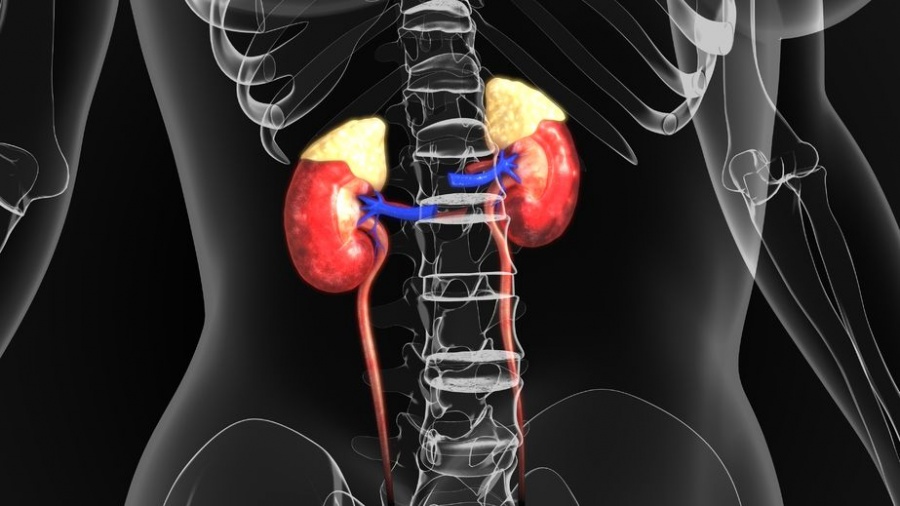Adrenal Tumors – Medical Science Notes – For W.B.C.S. Examination.
The adrenal glands are part of the endocrine system, which releases hormones into the blood system. Hormones are important in many body processes, including metabolism, sexual development and puberty, and stress.Continue Reading Adrenal Tumors – Medical Science Notes – For W.B.C.S. Examination.
There are two adrenal glands, one on the top of each kidney. They are shaped like triangles, and each is about ½ inch high and 3 inches long.
Each gland has two parts. The medulla is the inner part of the adrenal gland. It makes hormones called catecholamines, which include adrenaline and noradrenaline. These “stress hormones” increase alertness, strength and speed in an emergency. They also affect heart rate, blood pressure and sweating.
The outer part of the adrenal gland is called the cortex. It makes hormones that impact blood pressure, metabolism and how the body uses fats, carbohydrates and proteins.
Malignant Adrenal Tumors
Adrenocortical cancer: These tumors originate in the cortex of the adrenal gland. Adrenocortical cancer is rare, affecting only about 300 to 500 people each year in the United States. There are two main types of adrenocortical cancer:
- Functioning tumors are the most common type and account for about 70% of adrenal cancers. These tumors make hormones, such as cortisol, androgens or aldosterone.
- Non-functioning tumors do not produce hormones.
Malignant adrenal pheochromocytoma: This cancer begins in the medulla. It is extremely rare, with only about 800 cases are diagnosed each year in the United States.
Malignant paragangliomas: These tumors may begin inside or outside the adrenal gland.
Benign Adrenal Tumors
Adenomas: A type of non-cancerous tumor.
Benign pheochromocytomas
Benign paragangliomas
Cushing’s Syndrome: In patients with Cushing’s syndrome, the adrenal gland produces an excess of cortisol, a hormone that plays a part in regulating blood pressure, heart function and the body’s reaction to stress. Cushing’s syndrome is rare. About two to four new cases per 1 million people are diagnosed in this country each year.
Overproduction of cortisol may be caused by:
- A benign tumor on the adrenal gland called an adenoma
- An abnormality of the pituitary gland, usually a tumor (also called Cushing’s disease)
- Long-term use of corticosteroid medications (such as prednisone)
- Benign or malignant tumors in other areas of the body that produce adrenocorticotropic hormone (ACTH) (ectopic ACTH syndrome)
Hyperaldosteronism: This condition is caused by a small tumor in the adrenal gland that makes too much aldosterone or an enlargement (hyperplasia) of the adrenal glands. A high level of aldosterone plays a part in the body’s salt and potassium balance, and may cause high blood pressure. In fact, it is believed that 10% of people with high blood pressure have hyperaldosteronism.
Adrenal Tumor Risk Factors
Certain inherited disorders can increase your risk of having an adrenal disease. These include:
- Li-Fraumeni syndrome
- Multiple Endocrine Neoplasia type 2 (MEN2)
- Von Hippel-Lindau disease (VHL)
- Neurofibromatosis type 1, also known as von Recklinghausen’s disease
- Paraganglioma syndrome, a condition where tumors form in structures called paraganglia
- Beckwith-Wiedemann syndrome, a type of overgrowth syndrome
Not everyone with these syndromes develops an adrenal tumor. However, if you or anyone in your family has one of these syndromes, your doctor may recommend genetic testing. We offer the most advanced genetic testing to let you know your risk of developing adrenal gland tumors.
People with an adrenal gland tumor may experience the following symptoms or signs. Sometimes, people with an adrenal gland tumor do not have any of these changes. Or, the cause of a symptom may be another medical condition that is not a tumor.
- High blood pressure
- Low potassium level
- Heart palpitations
- Nervousness
- Feelings of anxiety or panic attacks
- Headache
- Excessive perspiration
- Diabetes
- Abdominal pain
- Unexplained weight gain or weight loss
- Weakness
- Abdominal stretch marks
- Excessive hair growth
- Changes in genitalia
- Unusual acne
- Change in libido (sex drive)
In addition, pheochromocytoma may cause dangerous surges of the hormones that regulate blood pressure and the body’s response to stress. A hormonal surge can cause blood pressure to rise very quickly, increasing the risk of a heart attack, stroke, hemorrhage, or sudden death.
If you are concerned about any changes you experience, please talk with your doctor. Your doctor will ask how long and how often you’ve been experiencing the symptom(s), in addition to other questions. This is to help find out the cause of the problem, called a diagnosis.
If a tumor is diagnosed, relieving symptoms remains an important part of medical care and treatment. This may also be called symptom management, palliative care, or supportive care. Be sure to talk with your health care team about symptoms you experience, including any new symptoms or a change in symptoms.
Please subscribe here to get all future updates on this post/page/category/website


 +919674493673
+919674493673  mailus@wbcsmadeeasy.in
mailus@wbcsmadeeasy.in







































































































